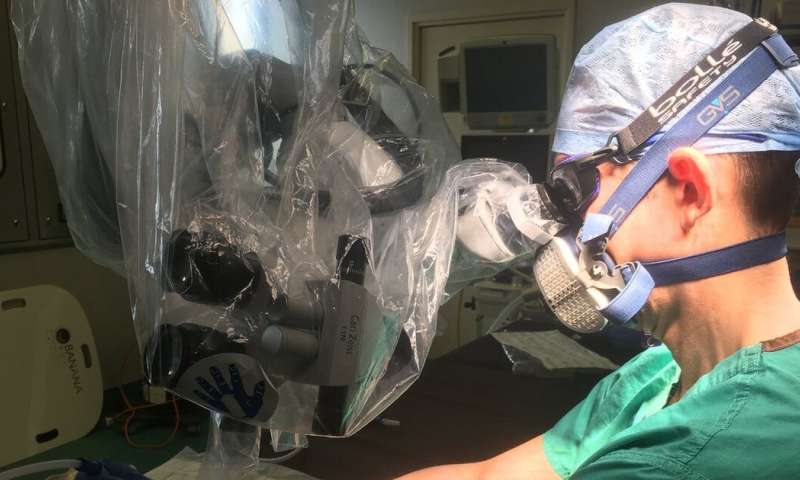
When the coronavirus pandemic first hit the UK, thousands of surgical procedures were put on hold. For a surgeon like me who performs operations on deaf children to restore their hearing, this created a significant moral dilemma—I wanted to get back into surgery to provide this vital care, but I didn’t want to inadvertently catch or pass on COVID-19 in the process.
I regularly carry out cochlear implant surgery, a process in which a surgeon embeds an electronic device which stimulates the hearing nerve in the ear. The scientific evidence is clear that this surgery needs to be performed at the earliest opportunity so that these children can benefit from being able to hear at a vital stage in their development.
But performing the surgery as normal would have put both children and surgical teams in danger. We needed to come up with another way of doing things. Our team in Nottingham had to combine creativity and science to develop a novel and safe way to restart cochlear implant surgery in a matter of just a few weeks.
A grave risk
Soon after the pandemic began, some of the earliest reports, notably those from China and Italy, suggested that healthcare workers were at significantly higher risk of contracting COVID-19 compared to the general public, and that treating ear, nose and throat (ENT) conditions was particularly risky.
I was deeply saddened when I was told that the one of the first healthcare workers in the UK to die of COVID-19 was Amged El-Hawrani, a 55-year-old ENT colleague from the university hospitals of Derby and Burton. El-Hawrani succumbed to this dreadful disease on March 28 in Leicester’s Glenfield hospital. Although I never had the pleasure of meeting him, his passing was a huge shock to us all. And his exposure to the virus during his care for his patients was a stark reminder of the brutality of this disease.
Like other ENT departments across the world, our service at Nottingham University Hospitals NHS Trust initially halted all elective procedures in March when the pandemic hit the UK, so we could concentrate our team’s efforts on the management of our sickest patients, including those conditions requiring emergency admission, and our cancer services.
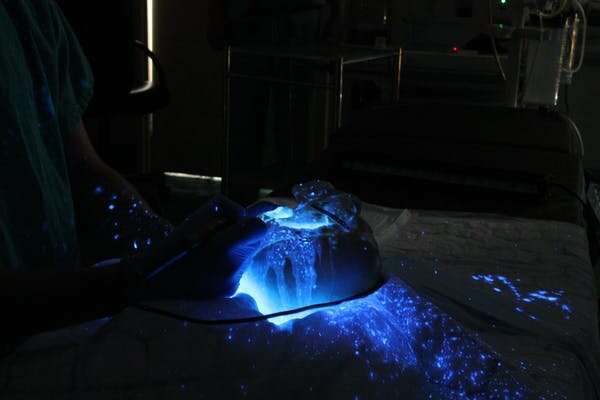
Although this initial response proved effective, we were aware that we were not meeting the needs of other patients with time-critical, albeit not life-threatening, conditions. These patients included children who are born deaf and need cochlear implant surgery to restore their hearing as quickly as possible to maximize their chances of developing normal speech and language. Delaying cochlear implant surgery can mean these young people usually never recover full speech and language skills.
We know this because a lot of the critical studies that highlighted the importance of early cochlear implantation on speech and language development were performed locally in Nottingham, which is home to a large number of world-leading hearing researchers. The first pediatric cochlear implant surgery in the UK was performed by the Nottingham Auditory Implant Program (NAIP) which hosts one of the largest children’s cochlear implant services in the UK.
A unique risk to ear surgeons
As a cochlear implant surgeon for NAIP, and a research lead for the Nottingham Biomedical Research Center, I was devastated that we were not able to provide our deaf children with the care they needed. That said, I will admit that the idea of performing cochlear implant surgery at the start of the COVID-19 outbreak was unnerving.
ENT healthcare workers are particularly at risk of catching coronavirus during surgery because of the unique nature of the parts of the body we focus on. The nose of an infected person contains a significant load of the SARS-CoV-2 virus that causes COVID-19. The nose is directly connected to the middle ear by a small channel called the eustachian tube, and other types of coronaviruses, including the one that causes the common cold, are commonly found in the middle ear. This means it is highly likely that SARS-CoV-2 also exists in the middle ear, though, no one has confirmed this to date.
The virus uses two proteins to enter human cells (ACE2 and TMPRSS2) that are found throughout the lining of the nose. The same proteins are found in the eye, suggesting that eye transmission is very likely. We also know that animals express both these proteins in their ears, again suggesting that SARS-CoV-2 is highly likely to be found there.
The virus is mainly transmitted via large droplets that require relatively close contact with an infected person. It has also been suggested that it can be transmitted via aerosols, much smaller particles that can spread over much longer distances.
Several medical procedures have been classed as “aerosol generating”, including cochlear implant surgery, which involves drilling into the bone behind the ear to access the middle ear. The high-speed drill we use during surgery can spread droplet and aerosol contamination throughout a confined theater space. These droplets and aerosols will contain a mixture of water, bone, blood, tissue and, potentially, viable viruses.
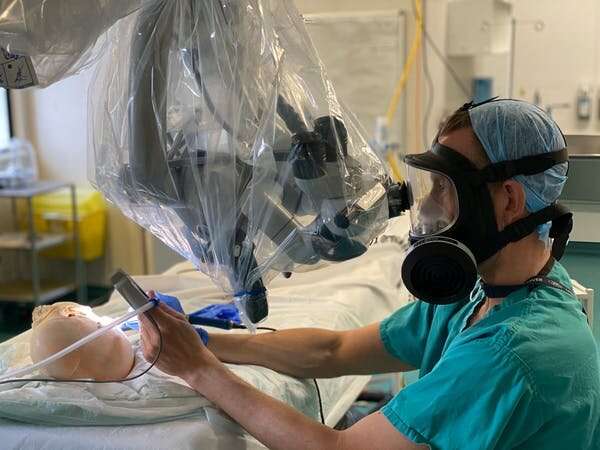
Fixing the problem
At the beginning of the outbreak, while we knew we needed to restart cochlear implant surgery urgently, we were also extremely aware of the potential risks associated with performing this operation at the height of the pandemic. This problem concerned me greatly. However, I find that the best way to manage concern is though action, and it was at this time that I was very grateful that I work in a city which hosts one of the UK’s largest cochlear implant programs.
In the matter of just a few days, following just a couple of brief emails, a few phone calls and the odd Zoom meeting, I managed to gather together a team of internationally recognized experts who were all interested in developing a model of cochlear implant surgery that we could follow during the pandemic.
My first port of call was Padraig Kitterick, head of hearing sciences at my university, who generously gave both his time and all the funds we needed to support this crucial work. Next, I contacted my esteemed surgical colleague, Gerry O’Donoghue, who pioneered cochlear implant surgery in the UK. As always Gerry was enthused to be involved. So much so that he also volunteered the expertise of his son, Kevin, who works with us as an anesthetist in the Queens Medical Center in Nottingham.
I then asked my colleagues from the anatomy facility if I could borrow enough skulls on which we conducted experiments that would help us analyze the risk of spreading droplets while performing surgery. Without a moment’s hesitation, Susan Anderson and her colleague Dominik Siwek replied, yes, of course they would be delighted to help. Likewise, Richard Hague and his colleagues from the faculty of engineering provided us with essential 3-D printing services to support our work.
Early one Saturday morning, along with Rachael Lawrence, an academic ENT surgeon in training, I collected the skulls from an otherwise deserted anatomy dissection room on one of the upper levels of the Queens Medical Center. We carried them to one of the ENT theaters located at the other side of the hospital that had been generously provided by our theater manager, Laura Mitchell.
Once our team was gathered, we got to work, fuelled by delicious cakes that had been baked by my youngest daughter Alice, decorated with rainbows in support for the NHS.
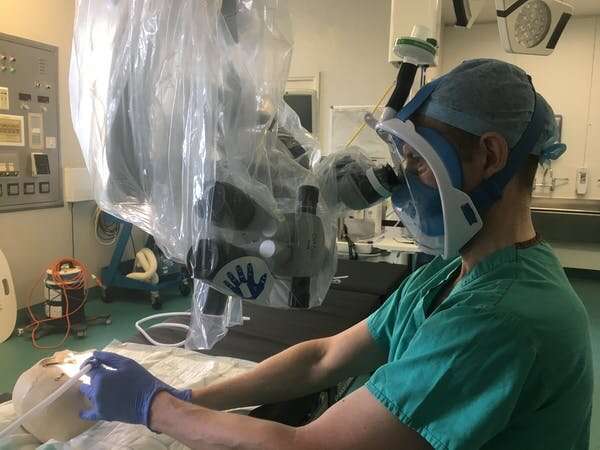
Our first task was to properly visualize the extent of droplet spread during cochlear implant surgery. To do this, we decided to replace the fluid that we normally use to irrigate our high-speed drilling with a fluorescent dye.
By simulating a cochlear implant operation using this setup, we could see where the dye landed and understand whether we could continue carrying out surgery wearing standard personal protective equipment (PPE).
It soon became apparent from the distribution of luminous dye around the theater that the contaminated droplets could spread more than two meters from the site of drilling in all directions. This not only includes the area that the surgeon works in, but also the nurses, the anesthetist, and other theater staff.
Even worse, we found that droplets easily migrated underneath our full-face visors, the standard recommended PPE for aerosol-generating procedures in the UK. The droplets landed very close to the eyes of the person wearing it. This suggested that a visor offered inadequate protection.
But we were not discouraged. Now we knew the extent of the problem, we were able to work around the clock for the next few weeks until we managed to develop and refine some rather unusual solutions.
Testing PPE
During our studies, we evaluated a variety of PPE options, along with several other infection control solutions. These included a full-face respirator and a combination of a half-face respirator and safety goggles, commonly known as “spoggles”. We had also read reports of teams, including one from Stanford University, who had modified a full-face snorkel mask to be used as PPE, so we tried this too.
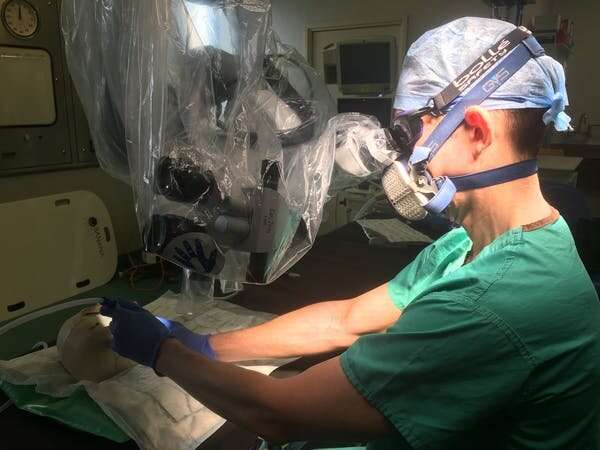
We used a systematic evidence-based approach to evaluate the PPE for its usability and effectiveness. During simulated cochlear implant surgery, we evaluated each type of PPE across several parameters, including its effect on a surgeon’s ability to communicate, their field of vision, and their comfort.
Many of the PPE options we tried, not least the full-face respirator, were found to substantially restrict the surgeon’s vision during operating. That rendered them unsafe for performing this sort of surgery. Rather worryingly, we also found that the modified snorkel mask that had been described by various groups on the internet was associated with rebreathing of carbon dioxide, so this was not a viable long-term option for PPE.
Instead, we found that the combination of “spoggles” and a half-face respirator mask had consistently superior performance across all aspects of clinical usability compared with all other options.
During our studies, we also worked with a surgical product manufacturer to develop a novel drape, basically a tent, that was designed to be suspended from a microscope covering the patient’s head and torso to provide a physical barrier between the site of drilling and the rest of the team.
We found that the operating tent significantly contained the droplets and prevented them from spreading around the theater environment. We were the first—and are currently only—group in the world to develop an operating tent design that is marked for medical use. After completing our studies, we now had appropriate PPE and a protective operating tent to permit the safe re-starting of cochlear implant surgery during the pandemic.
The new surgical normal
Our recommendations were rapidly disseminated internationally via webinars and journal publications and quickly adopted as standard patient care by our hospital trust and, subsequently, embraced in other departments in the UK and across the world.
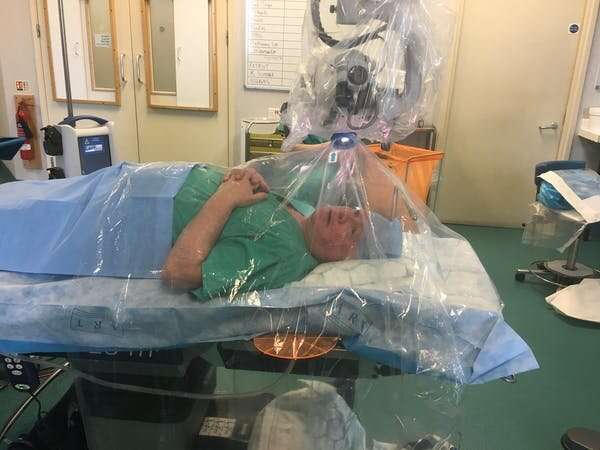
Locally, it was with huge relief that we recommenced cochlear implant surgery for profoundly deaf children after a few days of completing our studies: just a couple of months after this procedure was put on hold. Operating times were a little longer initially, and for the first few procedures we opted to have a backup surgeon available just in case the primary operating surgeon needed some help using this new setup.
Today, these new measures have become second nature to our theater team, operating times are comparable to our pre-COVID surgeries, and lists are running as before with just one surgeon operating. Apart from a little discomfort associated with wearing the PPE for long periods of time, and the ongoing detrimental impact of the PPE on communication, we have all pretty much accepted the setup as our new normal. In fact, I would go so far as to say, it would feel a little naked to operate without these measures now.
The safe recommencement of cochlear implant surgery in Nottingham, and in other centers around the globe, has given many hundreds of deaf children worldwide the chance to hear. These children can grow up with the potential to develop comparable speech and language skills to their peers. Without this timely surgical intervention, life would have been very different for these children and their families.
The value of speed and collaboration
The coronavirus crisis has been a strange and scary time for everyone, and it has presented us all with many significant challenges in how we live and work. But it has also opened a number of doors for new opportunities and possibilities.
Before COVID-19, if you told me that I’d need to construct a tent in which to operate this year, while wearing spoggles and a respirator mask, I would not have believed you. That said, I’m sure that most people would not have predicted how much we have all had to rely on Zoom and other new digital media to facilitate our work and social interactions with others over the past few months.
The process involved to translate a novel idea from the laboratory bench all the way through to implementation at the patient’s bedside is normally a very complicated and lengthy one that can take years, and sometimes decades, to complete. So it has been heartening to witness the value of a team working to solve a problem at breakneck speed, without much need for the phrase: “I don’t think we can do that.” Necessity is truly the mother of invention and, with a bit of luck, some of this innovation spirit will live on beyond the pandemic.
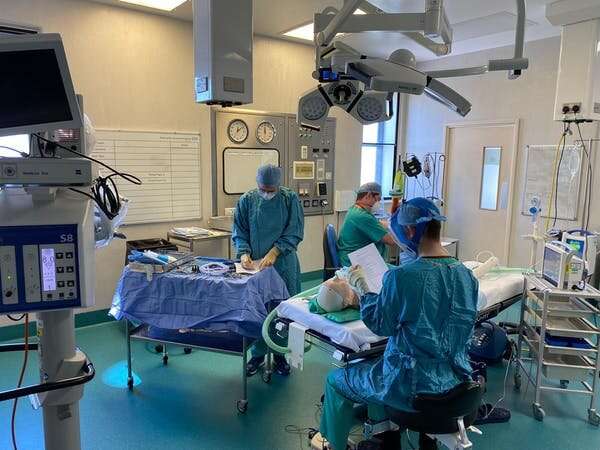
What next?
It seems that COVID-19 is likely to be with us for the foreseeable future. So we have no plans to abandon our PPE and operating tent for cochlear implant surgery any time soon. In fact, there is a strong argument among the surgical community that these measures should always be used to protect the theater team from potential contaminants, and the patient from exposure to infections in theater, regardless of the current pandemic.
Other surgical specialities have also been very interested in the operating tent method as an infection prevention control measure, including those that commonly use an operating microscope, such as spinal surgery, ophthalmology and neurosurgery. In the future we may see a wider use of operating tents.
Certainly, our theater teams face an ongoing problem from the negative impact of PPE on communication during surgery. It goes without saying that communication is critical for the safe functioning of an operating theater, and this problem needs an urgent solution. That’s why our group and other centers around the world are continuing to work on the design, not only to aid communication, but also to facilitate easy access into the tent for the surgeon and theater nurses, while keeping the contaminated droplets inside.
Source: Read Full Article
